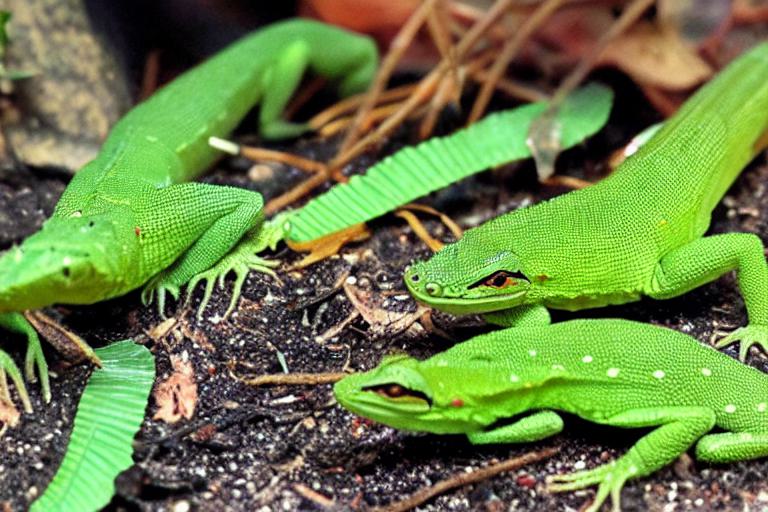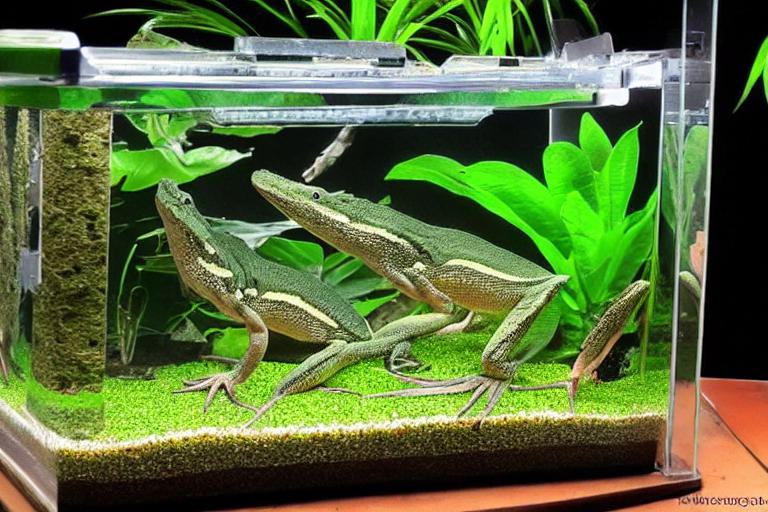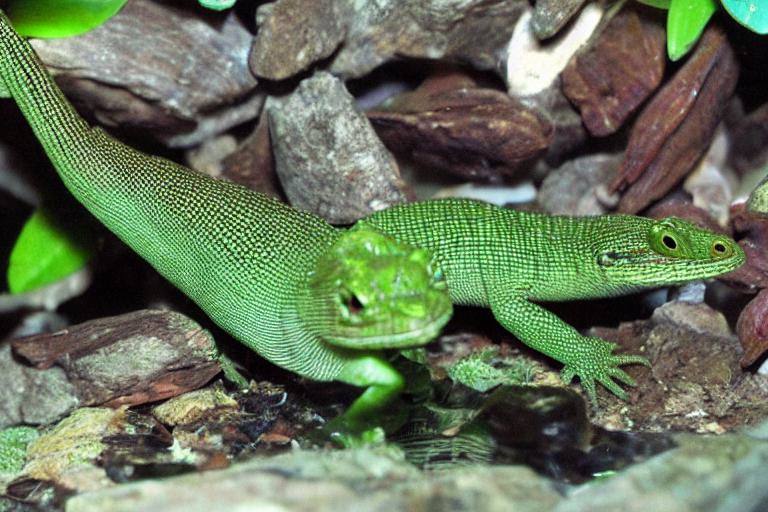If you’re thinking about setting up a paludarium and are wondering if you can include anoles as part of your animal inhabitants, you’re in luck. Anoles are a type of lizard that is native to the Americas and can do very well in a paludarium environment. In this article, we’ll discuss everything you need to know about keeping anoles in a paludarium, including their housing, diet, and care requirements.
The Best Types of Anoles for a Paludarium
There are many different types of anoles that can be kept as pets, but not all of them are well-suited to life in a paludarium. Some of the best anole species for a paludarium include the green anole (Anolis carolinensis), the brown anole (Anolis sagrei), and the Knight anole (Anolis equestris).
They are small lizards that are very active, and they enjoy climbing and perching on plants. Green anoles are also good swimmers, so they can enjoy the water features in a paludarium. Green anoles are one of the most popular anole species kept as pets, and they do well in paludariums.
Brown anoles are very hardy lizards, so they can tolerate a wide range of environmental conditions. They also enjoy climbing and perching on plants, and they are good swimmers. They are slightly larger than green anoles, but they are just as active. Brown anoles are another good choice for a paludarium.
Knight anoles do best in paludariums that have a lot of land area for them to explore. Knight anoles are the largest anole species, and they are very impressive lizards. They are very active and love to climb, but they are not good swimmers.

Green Anoles
Green anoles are a species of lizard that are native to the southeastern United States. Green anoles are one of the most popular pets in the reptile trade, and are frequently kept in captivity. They are commonly found in trees and shrubs, and are also known as American green lizards or tree lizards.
Green anoles are small lizards, with adults reaching a maximum length of around 8 inches. They are also good climbers, and are often seen basking in the sun on tree branches. Green anoles are diurnal, meaning they are active during the day. They are green in coloration, with a brown or black stripe running down the center of their back.
Green anoles are insectivores, and their diet consists primarily of small insects and spiders. In captivity, they can be fed a variety of live and frozen insects, as well as commercially-available lizard food pellets.
They can be kept in a variety of enclosure types, including glass aquariums, plastic tubs, and paludariums. When choosing an enclosure, it is important to provide plenty of hiding places and vertical space for the lizards to climb. Green anoles also require a source of UVB light, which can be provided via a special reptile bulb or fluorescent tube. Green anoles are relatively easy to care for, and make a good choice for beginner reptile keepers.

Brown Anole
Brown Anoles are active during the day, and can often be seen basking in the sun or running across open areas. It is one of the most common lizards in the southeastern United States, where it has been introduced. They are brown in color, with a light brown or tan stripe running down the center of their back. The Brown Anole is a species of lizard that is native to Cuba and the Bahamas. The Brown Anole is a small lizard, with adults reaching a total length of 8-10 inches.
Brown Anoles are good climbers, and are often seen perching on tree branches or fences. In the wild, Brown Anoles are found in a variety of habitats, including forests, fields, and gardens. They are also common in urban areas, and can often be seen sunning themselves on sidewalks or climbing walls.
They should also be provided with a basking spot, where they can warm themselves under a heat lamp. They can be kept in a variety of enclosure types, including terrariums, vivariums, and paludariums. Brown Anoles are relatively easy to care for in captivity, and make a great addition to any reptile collection. Brown Anoles do best in enclosures that provide plenty of hiding places and vertical space to climb. Brown Anoles are insectivores, and should be offered a diet of live insects, such as crickets, mealworms, and waxworms.
Ideal Tankmates for Anoles
If you’re looking for the perfect paludarium companion for your anole, consider these three options:
Geckos: Geckos make great tankmates for anoles because they are relatively small and docile. They are also good climbers, so they can help your anole get around the paludarium. Just be sure to choose a species of gecko that is not too aggressive, as some can be territorial. 1.
Frogs: Frogs are another good option for anoles, as they are also small and relatively docile. 2. They can help keep the paludarium clean by eating insects, and some species even enjoy sitting on your anole’s head! Just be sure to choose a species of frog that is not too large, as they can easily hurt your anole.
Lizards: Lizards make good tankmates for anoles because they are often the same size or smaller. 3. They can help your anole feel more secure in the paludarium by providing hiding places, and some species even enjoy basking in the sun together. Just be sure to choose a species of lizard that is not too aggressive, as some can be territorial.
Terrarium Tankmates
Terrarium tankmates can include other lizards, such as anoles, as well as frogs, toads, and newts. All of these animals require similar conditions in order to thrive, so it is important to do your research before adding any new pets to your terrarium.
You will also need to provide plenty of hiding places and perches for your lizards to climb on. Anoles, for example, can grow to be up to 8 inches long, so you will need to make sure your terrarium is large enough to accommodate them. When choosing terrarium tankmates, it is important to consider the size of your enclosure.
It is also important to make sure that your terrarium has a tight-fitting lid, as these animals are good climbers and may try to escape if given the chance. Frogs, toads, and newts can all be good tankmates for anoles, as long as you take care to choose species that are compatible in size and temperament.
Aquatic Tankmates
There are a few things to consider when choosing aquatic tankmates for your anole. They can help to keep the water clean and provide a place for your anoles to hide and escape the heat of the day. Aquatic tankmates can be a great addition to your paludarium.
Anoles are not very active themselves and can be easily overwhelmed by fish that are constantly swimming around. Anoles are small reptiles and can easily be eaten by larger fish. First, you will want to choose fish that are not too large. Third, you will want to choose fish that are not too active. Second, you will want to choose fish that are not too aggressive. Anoles are timid creatures and can be easily intimidated by aggressive fish.
These fish are all small, relatively peaceful, and not too active. Some good choices for aquatic tankmates for your anole include guppies, mollies, and swordtails.

How To Set Up a Paludarium for an Anole
A paludarium is a type of terrarium that contains both land and water. They are often found in trees and bushes near water sources. Anoles are a type of lizard that is native to the Caribbean and Central and South America. They are often used to recreate natural habitats, such as rainforests, and can be home to a variety of different animals.
The land area should be moist and humid, while the water should be shallow and clean. Live plants are the best option, as they will help to create the correct environment and provide food and shelter for the anoles. When setting up a paludarium for an anole, it is important to create a habitat that mimics their natural environment as much as possible. This means including both land and water areas, as well as plenty of plants and hiding places.
Anoles are relatively easy to care for and make interesting pets. With a little bit of planning, you can create a paludarium that will be the perfect home for your new pet anole.
Can Anoles Swim?
However, they prefer to live in fresh water. Yes, anoles can swim! They are strong swimmers and can even swim in salt water.

Sources
The most common and easiest way is to use an aquarium with a screen top. A 10-gallon aquarium is a good size for a pair of anoles. There are a few different ways that you can set up a paludarium for your anoles. You can also use a terrarium, vivarium, or even a plastic storage container. The size of the enclosure will depend on the number of anoles you plan on keeping.
Anoles are arboreal, so they will appreciate some branches or vines to climb on. If you are using an aquarium, you will need to add a layer of gravel or sand to the bottom for drainage. You will also need to add some live plants and a few pieces of driftwood or other decorations for hiding places.
The most important thing to remember when setting up a paludarium for your anoles is to make sure the humidity is high. You can achieve this by misting the enclosure several times a day or by using a humidifier. Anoles come from tropical environments and need a humid environment to thrive.
Frequently Asked Questions
1. What is a paludarium?
A paludarium is a type of terrarium that contains both land and water.
2. Can anoles live in a paludarium?
Yes, anoles can live in a paludarium as long as there is a land area for them to climb on and bask in the heat.
3. What type of water can be used in a paludarium?
Freshwater is the best type of water to use in a paludarium.
4. How often should the water be changed in a paludarium?
The water should be changed every week or two.
5. What type of plants can be used in a paludarium?
There are many types of plants that can be used in a paludarium. Some examples include ferns, mosses, and air plants.
6. How often should the plants be watered?
The plants should be watered when the soil is dry to the touch.
7. What type of lighting is best for a paludarium?
A paludarium should be lit with full-spectrum fluorescent bulbs.
8. How often should the bulbs be replaced?
The bulbs should be replaced every six months.
9. What type of substrate can be used in a paludarium?
There are many types of substrates that can be used in a paludarium. Some examples include gravel, sand, and soil.
10. How deep should the substrate be?
The substrate should be at least two inches deep.
Final thoughts
Yes, anoles can live in a paludarium! A paludarium is a semi-aquatic enclosure that is perfect for these little lizards. They will need a basking area, plenty of hiding spots, and a source of fresh water. Anoles are relatively easy to care for and make a great addition to any home.
